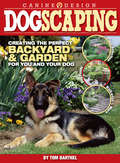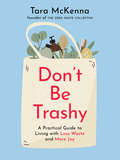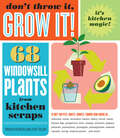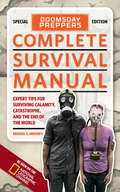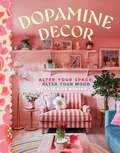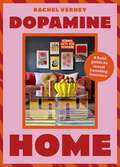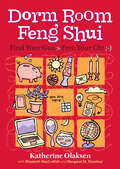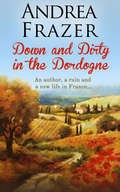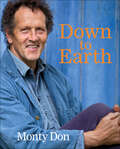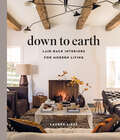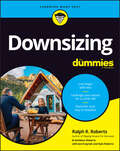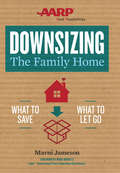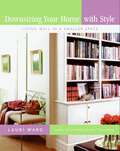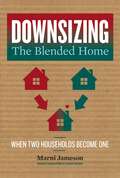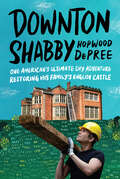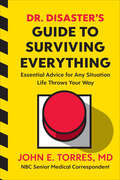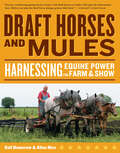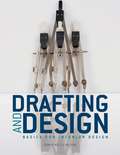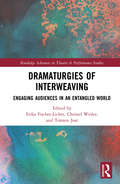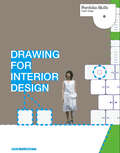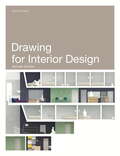- Table View
- List View
Dogscaping
by Thomas BarthelFor dog owners and garden lovers alike, Dogscaping presents a plan for the family dog to live in perfect harmony with a green, beautiful backyard. Whether the family dog is a demon digger like a terrier or a shade-seeking greyhound, Dogscaping offers solutions for all dog owners to create the perfect backyard and garden for all members of the human and canine family. Tom Barthel, a certified master gardener and devoted dog owner, approaches the topic of landscaping for dogs organically-figuratively and literally, whenever possible. Encouraging the reader to pursue organic methods, the author includes a terrific chapter on organic lawns and offers tips for maintaining an earth-friendly (and dog-friendly) green-as-can-be lawn. Between the chapters of this book are profiles called "Organic Gardener: Organic Dog," in which he tells entertaining success stories of dog-owning organic gardeners and hobby farmers. In the chapter "Site Planning and Plant Selection," Barthel advises on how to plan the backyard space taking the dog's habits and proclivities in mind and then makes recommendations for various kinds of vines, groundcovers, shrubs, and urine-resistant plants. In its chapter about maintaining the garden and backyard, Dogscaping presents various organic pest and weed control options, which are safe for the dog and practical for the gardener. The author also offers a list of pest-discouraging plants and methods to deter unwanted weeds and visitors (gophers, deer, squirrels, etc.). In the greenest chapter in the book, "Recycling Home, Garden, and Yard Waste," Barthel makes a compelling case for composting, cataloging both the advantages and savings and offering an easy five-step method of composting. Other additions to the dog-friendly backyard include planting fruits and vegetables, adding a water feature, and incorporating decks, gazebos, pathways, and lighting, all of which are covered in individual chapters in this beautifully photographed book. The final chapter of the book "Creating Doggy Nirvana" provides fun ideas for owners to include dog-specific features into their backyard designs, including a pooch pergola, doggy sandbox, and disappearing fountain. The appendix provides US and North American zone maps. Index included.
Don't Be Trashy: A Practical Guide to Living with Less Waste and More Joy
by Tara McKennaGet beyond the Mason jar and learn how to dramatically reduce the waste you produce over the course of a year—one sanity-saving step at a time—in this super-practical guide from the creator of The Zero Waste Collective. Say goodbye to your bursting toiletries bag, fast fashion, and all the plastic crowding your pantry. It's time to build less trashy habits for a more sustainable and ethical life. With relatable stories, compassion, and a realistic perspective, Tara McKenna will show you how in this ultimate guide to going zero waste(ish). We're all trapped in a wasteful convenience-based cycle, but Don&’t Be Trashy offers an alternative: an approach to reducing waste that emphasizes progress over perfection. McKenna guides you month by month through a year of reducing consumption, covering: • Decluttering and turning off the flow of stuff into your home • Breaking up with fast fashion and developing a capsule wardrobe • Cutting off your supply of single-use plastic in your kitchen, cleaning supplies, and bathroom • Investing in home goods that'll last for decades without breaking the bank • And more! Ultimately, it's about changing your mindset to one of minimalism and conscious consumption—a mindset that&’s as good for your wallet and your well-being as it is for the planet. Don't Be Trashy will guide you to your best life—one with less waste and more joy!
Don't Throw It, Grow It!: 68 windowsill plants from kitchen scraps
by Deborah PetersonDon’t throw out your kitchen scraps — grow them! Discover how you can transform leftover pomegranate seeds, mango pits, and dried bits of gingerroot into thriving plants. From the common carrot to the exotic cherimoya, you’ll be amazed at the gardening possibilities hidden in the foods you eat.
Doomsday Preppers Complete Survival Manual
by Michael SweeneyThis custom companion to the blockbuster National Geographic Channel series Doomsday Preppersis filled with how-to illustrations, "Prepper Profiles" of people in the show, and survival tips from preppers themselves. Handy and comprehensive, the manual offers valuable life-saving information to help prepare for the most devastating calamities. Episodes of this highly original show, which debuted in February 2012, explore the lives of otherwise ordinary Americans who are preparing for the end of the world as we know it. Preppers go to extraordinary lengths to plan for any of life's uncertainties, from constructing a home out of shipping containers and stockpiling 50,000 lbs. of food to practicing evacuation drills and hand-to-hand combat. This book is an essential component.
Dopamine Decor: Alter Your Space, Alter Your Mood
by Kate Rose MorganEmbrace colorful, maximalist style and create the home that makes you happy with Dopamine Decor, a lushly photographed ode to joyful interiors from design expert and social media star Kate Rose Morgan. Find your color confidence with Dopamine Decor, an aspirational yet practical guide to vibrant, maximalist style. Throughout this playful, joy-filled book, design expert and proud color lover Kate Rose Morgan (@kate_rose_morgan) teaches readers of all kinds how to channel the aesthetic that makes them happy, to create the homes of their dreams. Inside you'll find: Guidelines for finding your comfort color and design vision. Ways to connect with your "inner child" as you hone your aesthetic and find joy. Practical guidance on paint, DIY projects, and achieving balance. Tips for both homeowners and renters on how to brighten up any space. Budget-friendly ideas for introducing playfulness into your home. Inspirational images from dozens of colorful homes around the world. Personal stories from Kate's own colorful home transformation.
Dopamine Home: A bold guide to mood-boosting interiors
by Rachel VerneyCreate a joyful, mood-boosting home through the transformative power of dopamine decor.Bold use of colour, energetic patterns, a mixture of textures: dopamine decor is all about getting your neurotransmitters pumping to unlock joy and showcasing your personal style.In this inspirational book, interiors expert Rachel Verney (aka @the_shoestring_home) shares the core principles of dopamine decor, her creative ideas and hacks, colour theory, and DIY projects for every budget. With easy-to-follow steps, get started on upholstering a headboard, painting tiles, upcycling a cocktail cabinet, or building your own pergola.Filled with stunning interiors photography, this is your ultimate guide to creating your very own colourful, dopamine-inducing haven at home.
Dopamine Home: A bold guide to mood-boosting interiors
by Rachel VerneyCreate a joyful, mood-boosting home through the transformative power of dopamine decor.Bold use of colour, energetic patterns, a mixture of textures: dopamine decor is all about getting your neurotransmitters pumping to unlock joy and showcasing your personal style.In this inspirational book, interiors expert Rachel Verney (aka @the_shoestring_home) shares the core principles of dopamine decor, her creative ideas and hacks, colour theory, and DIY projects for every budget. With easy-to-follow steps, get started on upholstering a headboard, painting tiles, upcycling a cocktail cabinet, or building your own pergola.Filled with stunning interiors photography, this is your ultimate guide to creating your very own colourful, dopamine-inducing haven at home.
Dorm Room Feng Shui: Find Your Gua, Free Your Chi
by Katherine Olaksen Margaret M. Donahue Elizabeth MacCrellishCramped quarters, homesick roommates, and endless hours of schoolwork are just some of the challenges that can make living in a college dorm a stressful experience. Transform your small, concrete block of a room into a comfortable and productive living space using the ancient Chinese art of feng shui. Offering a variety of quick and inexpensive solutions, this guide will help you prioritize your most pressing problems, enhance your dorm room’s chi, and create a living arrangement that encourages positivity.
Down and Dirty in the Dordogne
by Andrea FrazerThis is the story of how two middle-aged Brits gave up a nice life in Blighty after falling in love with a delightfully dilapidated old French property.It’s no mean feat trying to restore a cavernous barn of a house (hovel) during the worst financial crisis of the modern age, especially when you’re faced with dodgy builders, red tape, rowdy locals, health problems, recalcitrant relatives, a house in England that simply won’t sell, and a multitude of escapologist cats – not to mention some resident skeletons.Andrea Frazer gives the lowdown on the ups and downs that befall two fish out of water as the couple take the plunge and move across the Channel.
Down and Dirty in the Dordogne
by Andrea FrazerThis is the story of how two middle-aged Brits gave up a nice life in Blighty after falling in love with a delightfully dilapidated old French property.It’s no mean feat trying to restore a cavernous barn of a house (hovel) during the worst financial crisis of the modern age, especially when you’re faced with dodgy builders, red tape, rowdy locals, health problems, recalcitrant relatives, a house in England that simply won’t sell, and a multitude of escapologist cats – not to mention some resident skeletons.Andrea Frazer gives the lowdown on the ups and downs that befall two fish out of water as the couple take the plunge and move across the Channel.
Down to Earth: Gardening Wisdom
by Monty DonWritten as he talks, this is Monty Don right beside you in the garden, challenging norms and sharing advice.Discover Monty's thoughts and garden ideas around nature, seasons, color, design, pests, flowering shrubs, containers, and much more. Read about the month-by month jobs he does in his own garden that he hopes are relevant to you. Monty's intimate and lyrical writing is accompanied by photos of his garden, showing areas rarely seen on television. This is the perfect gift for the gardener in your life."I have written many gardening books but this is the distillation of 50 years of gardening experience. It has all the tips and essential pieces of knowledge that enable you to make your garden grow well, and it also shares my view that gardening is the secret to living well too." - Monty
Down to Earth: Laid-back Interiors for Modern Living
by Lauren LiessThe designer and author of Habitat “shares how she imbues any space with warmth and energy” in this elevated yet accessible follow-up (MarthaStewart.com).Down to Earth picks up right where Lauren Liess’s critically acclaimed Habitat left off. While Habitat walked readers through the decorating process step-by-step, Liess’s latest title takes a step beyond the basics and invites readers to incorporate the main components of her familiar design aesthetic: nature, easy living, and approachability. With evocative photos and substantive design advice, Down to Earth focuses on creating a lifestyle that inspires creativity and functionality. Throughout the book, Liess shows readers how to incorporate six guiding principles in six unique homes: a new farmhouse, a classic American historical home, a lakeside contemporary house, a modern villa, a turn-of-the-century American Foursquare, and a cedar and glass house on a bluff. While each home has a different architectural style, fingerprints of Liess’s down-to-earth style are evident throughout. “Full of the stunning images you would expect. They will spark your creativity and inspire your own designs. However, the real beauty comes from Lauren showing readers how to create ease in their own homes.” —Ariadne Shoppe“Her style embraces lived-in, vintage-inspired interiors . . . Her philosophy is that if your home is relaxed, then you’re relaxed.” —One Kings Lane
Downsizing For Dummies
by Ralph R. Roberts Joseph Kraynak Kyle Roberts Kathleen RobertsOrganize, declutter, donate—downsize and simplify your life Downsizing For Dummies provides you with strategies to downsize your life by moving to a smaller home, decluttering, simplifying your budget, and saving more money. You&’ll find tips to help decrease your cost of living, lower your home maintenance costs, protect and leverage your assets, and decide whether downsizing is right for you and your family. After downsizing your life, you&’ll save time on household chores and gain the freedom and flexibility that come with having fewer possessions. What will you do with all the time you save? Downsizing For Dummies will help you understand the benefits of living simply! Discover ways to declutter and simplify every corner of your life Weight the pros and cons of moving to a smaller home Save time and money by cutting down on your chores and home maintenance Experience a reduced stress level when you create space at home and workThis book is for anyone who is ready to live clutter-free and to downsize. It&’s the perfect Dummies guide for homeowners looking to save money, plus real estate brokers who are working with clients who are downsizing, and designers and builders of new homes who want to stay on top of the downsizing trend.
Downsizing The Family Home: What to Save, What to Let Go (Downsizing the Home #1)
by Marni JamesonIt&’s a rite of passage almost no one will escape: the difficult, emotional journey of downsizing your or your aging parents' home. Here, nationally syndicated home columnist Marni Jameson sensitively guides readers through the process, from opening that first closet, to sorting through a lifetime's worth of possessions, to selling the homestead itself. Using her own personal journey as a basis, she helps you figure out a strategy and create a mindset to accomplish the task quickly, respectfully, rewardingly—and, in the best of situations, even memorably. Throughout, she combines her been-there experience with insights from national experts—antiques appraisers, garage-sale gurus, professional organizers, and psychologists—to offer practical wisdom and heartwarming advice so you know with certainty what to keep, toss or sell.
Downsizing Your Home with Style: Living Well In a Smaller Space
by Lauri WardWhen you're moving a lifetime's accumulation of belongings from a larger home into a jewel box, the task can seem overwhelming—and so can your emotions. How do you decide what to pack and what to part with? How can you use the things you have so that they function well and look right?Downsizing Your Home with Style answers these questions and more. Learn how to:Create more storage Make your stuff look smaller and your space look bigger Update and modernize your favorite old pieces Multipurpose your rooms and furniture Find a new home for the stuff you no longer need From the initial evaluation of your new home to one year after you have settled in, interior designer Lauri Ward takes you through every step with detailed tips, lists of good buys, tricks of the trade, photographs, and anecdotal examples, so that achieving spectacular results is simple and affordable, whatever your style or budget.
Downsizing the Blended Home: When Two Households Become One (Downsizing the Home #3)
by Marni JamesonA book to help those who are merging their hearts, lives, and homes. When merging households, one plus one needs to equal . . . one. The path toward that fundamental fact, however, is not so easy. Since something&’s got to give—and you don&’t want it to be the relationship—Downsizing the Blended Home is here to help you meet the challenge of figuring out what to keep, what to let go of, and what to create together. With the same warm, narrative tone that made Downsizing the Family Home such a success—and using her own story of marriage and merger in midlife as a backdrop—Marni Jameson guides you through the turf wars and transitions, so you understand what matters and what doesn&’t, and can discover a style that suits you both. Along the way she interviews psychologists, designers, and couples who&’ve made it through the process, passing along tips, tricks, and marriage-bolstering advice.The wise advice includes: If you want to transform a space from me to we, the fastest, cheapest way is with paint.Look around you for the five or so nonnegotiable items that ground you, items that tether you so you&’re not adrift. Give those a place in your remodeled space and build on them.The old marital bed is a charged item, as are family photos of the former spouse or partner. A new bed is ideal, and new bedding is a must. Injecting a contemporary rug or piece of art, or a modern lamp or sculpture is a safe way to start moving toward modern in a room full of traditional furnishings.A blend in the master bedroom is especially important. If her bedroom is pink and purple, and his is burgundy and tan, a new gender-neutral color scheme is in order.Buying furniture together is a great way to invest in your look and your future. Start with something big in your combined style.
Downton Shabby: One American's Ultimate DIY Adventure Restoring His Family's English Castle
by Hopwood DePreeHGTV meets Downton Abbey! A ready-for-TV story—with charm and humor in abundance—about a Los Angeles producer who moves to England to save his ancestral castle from ruin.“A true delight...In this marvelous debut, film producer DePree leaves the Hollywood hills to resurrect his British ancestral home, a 50,000-square-foot estate in the English countryside. Readers are in for a treat."--Publishers Weekly (starred review)Hollywood producer Hopwood DePree had been told as a boy that an ancestor—who he was named for—had left his family’s English castle in the 1700s to come to America. One night after some wine and a visit to Ancestry.com, Hopwood discovered a photograph of a magnificent English estate with a familiar name: Hopwood Hall, a 60-room, 600-year-old grand manor on 5,000 acres. And with that, Hopwood DePree’s life took an almost fairytale turn.Hopwood Hall, in northwest England, was indeed his family’s ancestral home. It had been occupied continuously by the Hopwood family for five centuries until the last remaining male heirs were killed in World War I. Since then, the Hall had fallen gradually into disrepair and was close to collapse. When Hopwood visited, he discovered trees growing in the chimneys, holes in the roof, and water sluicing down walls. It would take many millions to save the Hall—millions that Hopwood certainly didn’t have—but despite the fact that he lived in Los Angeles and had no construction skills, Hopwood DePree came to a conclusion: He would save Hopwood Hall.Downton Shabby—the name Hopwood coined for the glorious ruin—traces Hopwood DePree’s adventures as he gives up his life in Hollywood and moves permanently to England to save Hopwood Hall from ruin. But the task is far too big for one person, of course. Hopwood discovers that the Hall comes with an unforgettable cast of new neighbors he can call on for help—from the electrician whose mum had fond memories of working at the Hall to gruff caretaker Bob, and the local aristocrats who (sort of) come to accept Hopwood as one of their own. Together, as they navigate the trials and triumphs of trying to save an actual castle, Hopwood finds himself ever further from the security of his old life, but comes to realize that, actually, he’s never been closer to home.
Dr. Disaster's Guide to Surviving Everything: Essential Advice for Any Situation Life Throws Your Way
by John E. TorresFrom an ER doctor and Special Forces instructor, an all-encompassing guide to preparing for disasters both natural and man-made. An emergency room physician and U.S. Air Force veteran, Dr. John Torres, aka “Dr. Disaster,” has spent his career on the front lines, saving lives in all sorts of disasters. From treating trauma patients to serving in rescue missions in Antarctica to covering the country’s latest crisis as an NBC senior medical correspondent, his entire job is to think about best practices in emergencies—and now he’s sharing his hard-won knowledge.Dr. Torres provides essential advice for surviving worst-case scenarios from natural disasters like lightning strikes, hurricanes, and wildlife encounters to human-made ones like terrorist attacks and active-shooter situations. Engrossing and informative, this book is full of hacks that could save your life, such as:How to prep your home for any emergencyWhy you should never use a landline during a thunderstormThe safest place to sit on an airplaneWhat to do during civil unrest or cyberattacksWhat to pack in a “bug-out bag”How to start a fire with common household itemsThe first thing you should do every time you enter a shopping mallAlso included is a chapter on how to teach kids to be alert and prepared—without freaking them out. Organized by topic, this is a valuable guide to protecting yourself and your loved ones in an unpredictable world.
Draft Horses and Mules: Harnessing Equine Power for Farm & Show
by Gail Damerow Alina RiceHardworking and intelligent, draft horses and mules provide clean-energy power for an impressive array of tasks. Bringing strength and endurance to every job, from cultivating farmland and hauling logs to giving long quiet rides through the countryside, these animals love to work. In this illustrated guide, Gail Damerow and Anita Rice provide all the information you need in order to select, train, feed, care for, and work with your own team of draft horses or mules.
Drafting and Design: Basics for Interior Design
by Travis Kelly WilsonUsing a residential design scenario that increases in scope from chapter to chapter and results in a complete set of working drawings, Drafting and Design: Basics for Interior Design teaches the art of drafting through hands-on application. Introducing essential drafting tools, equipment, and methods, the book is designed to help interior designers develop an understanding of space planning and leverage manual drafting skills to design usable and livable space.
Dramaturgies of Interweaving: Engaging Audiences in an Entangled World (Routledge Advances in Theatre & Performance Studies)
by Erika Fischer-Lichte, Christel Weiler and Torsten JostDramaturgies of Interweaving explores present-day dramaturgies that interweave performance cultures in the fields of theater, performance, dance, and other arts. Merging strategies of audience engagement originating in different cultures, dramaturgies of interweaving are creative methods of theater and art-making that seek to address audiences across cultures, making them uniquely suitable for shaping people’s experiences of our entangled world. Presenting in-depth case studies from across the globe, spanning Australia, China, Germany, India, Iran, Japan, Singapore, Taiwan, Vietnam, the US, and the UK, this book investigates how dramaturgies of interweaving are conceived, applied, and received today. Featuring critical analyses by scholars—as well as workshop reports and artworks by renowned artists—this book examines dramaturgies of interweaving from multiple locations and perspectives, thus revealing their distinct complexities and immense potential. Ideal for scholars, students, and practitioners of theater, performance, dramaturgy, and devising, Dramaturgies of Interweaving opens up an innovative perspective on today’s breathtaking plurality of dramaturgical practices of interweaving in theater, performance, dance, and other arts, such as curation and landscape design.
Drawing and Reinventing Landscape, AD Primer
by Diana BalmoriHow to tackle representation in landscape designRepresentation is a hot topic in landscape architecture. While computerization has been a catalyst for change across many fields in design, no other design field has experienced such drastic reinvention as has landscape architecture. As the world urbanizes rapidly and our relationship with nature changes, it is vitally important that landscape designers adopt innovative forms of representation--whether digital, analog, or hybrid.In this book, author Diana Balmori explores notions of representation in the discipline at large and across time. She takes readers from landscape design's roots in seventeenth-century France and eighteenth-century England through to modern attempts at representation made by contemporary landscape artists.Addresses a central topic in the discipline of landscape architectureFeatures historic works and those by leading contemporary practitioners, such as Bernard Lassus, Richard Haag, Stig L Andersson, Lawrence Halprin, and Patricia JohansonWritten by a renowned practitioner and educatorFeatures 150 full-color imagesDrawing and Reinventing Landscape, AD Primer is an informative investigation of beauty in landscape design, offering inspiring creative perspectives for students and professionals.
Drawing for Interior Design
by Drew PlunkettThis book covers all stages of visual presentation as part of the interior design process, from the most basic initial sketches, to models, to fully developed computer-generated visualizations. In four chapters this easy-to-follow text explains the basics, conception, presentation and production. With a varied and comprehensive range of images, this book is an invaluable, inspirational and practical resource for interior architecture and design students and practising interior designers alike.
Drawing for Interior Design (Portfolio Skills)
by Drew PlunkettThis book covers all stages of visual presentation as part of the interior design process, from the most basic initial sketches, to models, to fully developed computer-generated visualizations. In four chapters this easy-to-follow text explains the basics, conception, presentation and production. With a varied and comprehensive range of images, this book is an invaluable, inspirational and practical resource for interior architecture and design students and practising interior designers alike.
Drawing for Interior Design Second Edition
by Drew PlunkettThis book covers all stages of visual presentation as part of the interior design process, from the most basic initial sketches to fully developed computer-generated visualizations. Following a brief introduction four chapters take the reader through the design process, from the basics to conception, presentation and production. This second edition includes more practical advice on techniques, more case studies, step-by-step sequences and updated examples. With a varied and comprehensive range of images, this book is an invaluable, inspirational and practical resource for interior design students.
